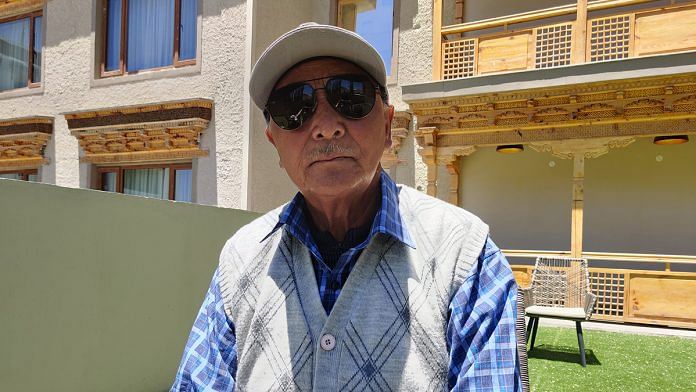Leh: After India and China decided to start the process of de-escalation along the Line of Actual Control, tensions are still rife, notably in the Ladakh region. While many have been calling for war, revenge or at least a boycott of Chinese-made goods, quite a different message comes from Naik Elihud George, who served in the 1962 war between India and China.
Meeting ThePrint’s team in Leh, the war veteran, who lives on the outskirts of Ladakh, recalled his and his platoon’s experience of the harsh terrain of the Galwan Valley. A frozen river with ice chips that cut into the bare feet of soldiers’, Naik George called this a “punishing terrain” that even horses didn’t survive.
He also pointed out that in terms of arms and ammunition, both countries are now in a very different place than they were in 1962. For instance, both are nuclear powers, and so any escalation could lead to a World War-like situation, which must be avoided, George said.
Also read: Galwan Valley has been & will always be India’s, says grandson of explorer it’s named after
Punishing terrain of Eastern Ladakh
Of the 20 Indian soldiers who died on the intervening night of 15 and 16 June in Eastern Ladakh’s Galwan Valley, several had died from hypothermia after falling into the freezing waters of the Shyok River with injuries.
Recalling the 1962 war, 77-year-old Naik George said that the terrain in Galwan Valley was just as punishing then, and survival at 18,000 feet is extremely difficult. “My platoon started with 30 men and 130 horses on a 13-day journey to reach Galwan Valley. By the time we reached Daulat Beg Oldie, we were left with 90 horses though our men managed to survive,” he said.
Reaching Galwan Valley by crossing the Shyok river, also known as the river of death, was a herculean task, he said.
“We had to cross the freezing Shyok river barefoot in March 1962. There were pieces of ice that cut through our bare feet, but we had to go along. After the Shyok, we had to cross the Chip Chap river, which flows in a zig-zag manner. It took us 180 tries to cross it. We set up camp along the Galwan River and on the 13th day, we reached Daulat Beg Oldie,” he recalled.
Also read: 14-day quarantine waived for Army, Navy, Air Force amid India-China row, but riders apply
‘Diplomatic solution only way out’
The face-off on 15 June is the first bloody clash between India and China in several decades. It was a culmination of events that began weeks before, when reports of Chinese construction activity emerged in May. Naik George said there was a similar pattern of events in 1962.
“When we reached Daulat Beg Oldie, we realised that the Chinese had already built roads behind the Karakoram Range. We found that road building would even continue in night with one lantern attached to each PLA soldier’s back. And then finally, on the night of 22 October, the Chinese attacked three of our posts,” he said.
Now, Naik George’s son is a Havildar deputed at Pangong Lake and is facing the Chinese just as his father did almost six decades ago.
The war veteran, however, explained that India in 2020 is not the same country as it was in 1962.
“Now we have all the sophisticated weaponry that the Chinese have. We no longer fight wars with rifles and swords as we used to. Both sides are nuclear powers and an escalation may result in a World War III-like scenario, with different countries siding with either India or China. A diplomatic solution is essential and must be found to ensure that such a dangerous escalation can be avoided,” he said.
Also read: How Indian troops chased the Chinese for a kilometre over LAC in Galwan on 15 June night




Need not worry anymore. China won’t let any Indians go there anymore.